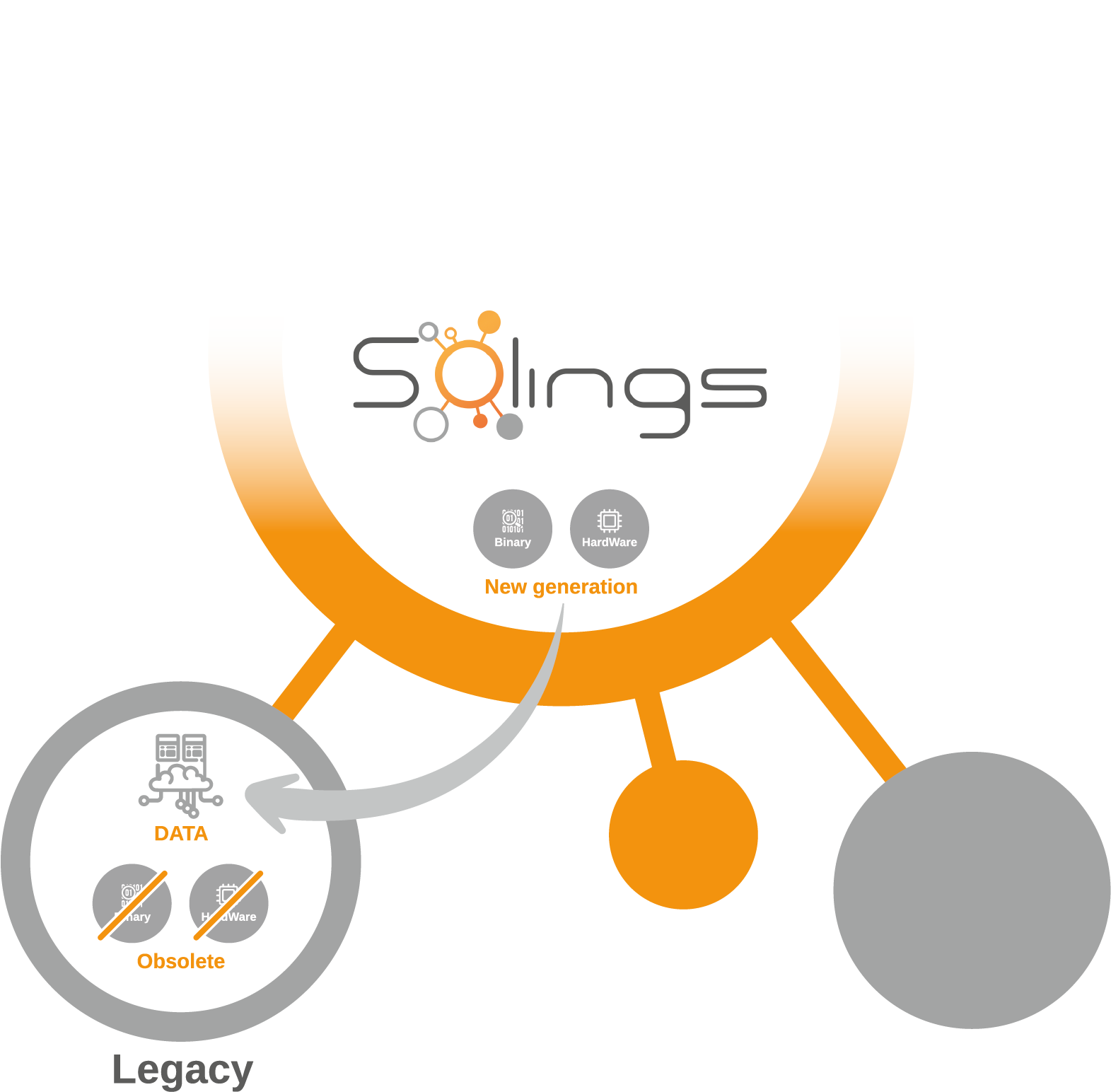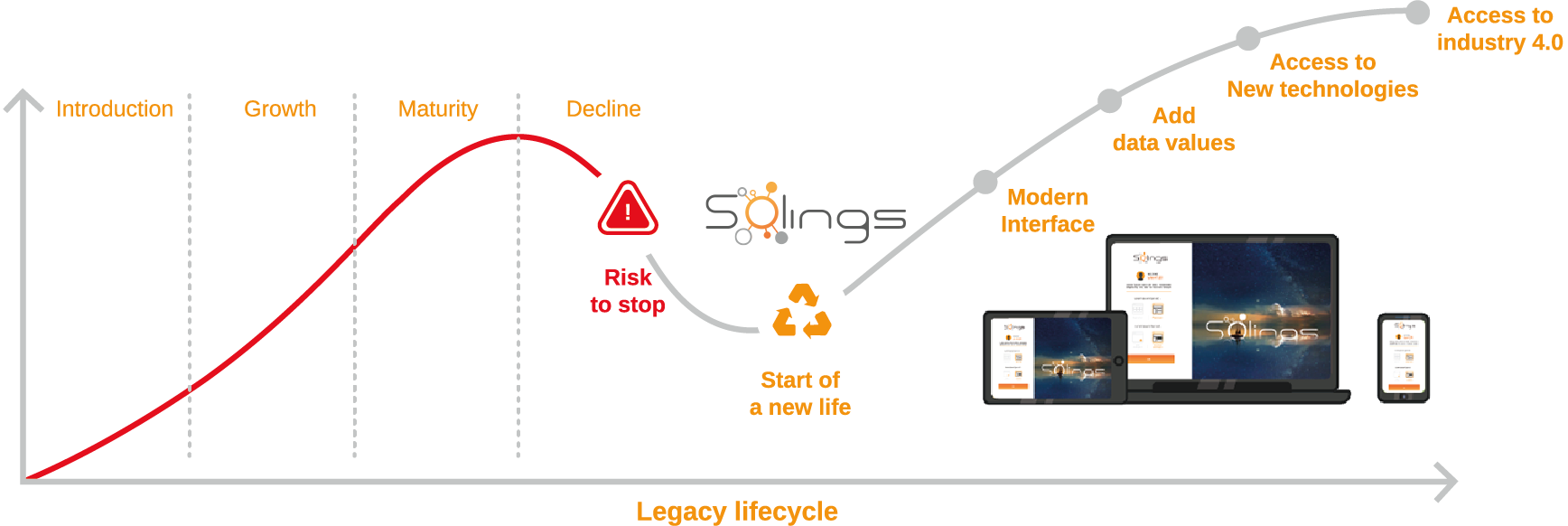Product
Our solution for managing PLM obsolescence
Some background information
In many cases, product data must live for 50 years or more, twice the lifespan of the IT systems that manage the data.
The obsolescence of legacy systems is a major challenge that can cause serious risks to business and industries worldwide due to a number of factors. First off, software licenses expire or become incompatible with new standard (e.g. 32-bit versus 64-bit). Secondly, the hardware itself becomes obsolete and needs to be replaced. This creates the third issue of moving the data to a supported system while maintaining access to the data. Lastly, the previous generation of systems requires expert users who are going into retirement leaving them unusable for the next generation.
These factors all work against the industry drivers around digital transformation.
The old systems become legacy systems and hinder the access to critical data in major industries.
This has consequences:

Bugs and compatibility issues are multiplying. Critical data can become unavailable. The repair is costly with uncertain outcomes.
- Norms are evolving fast, whilst software are not: for instance, an Industrial will fail to exchange data package directly through Secured Internet Connection with its supplier, due to the limitation of an hardware unable to use an External Encrypted Hard Drive (EEHD) with code to transfer via a secure courier. Another example: the limitation of an INTEGER had been reached compared to the hardware server that was blocked in 32 bits (2 147 483 647) knowing that on 64 bits hardware server the INTEGER limit is 9 223 372 036 854 775 807. The use of this application was blocked during three weeks.
- In spite of the intervention of expert IT repair by the editor, the compatibility issues will persist over time.
- Therefore, maintaining legacy systems up and running is unavoidably pointless. For instance, in the aircraft industry, it will cost around 10M€ per year by program for an aircraft manufacturer to continue to use the old systems.
The risk is to Stop the production caused by the lack of access to critical data. These incidents have heavy impacts on the business. About 25% of the companies that experienced a shutdown of their production line last year due to obsolescence of legacy systems, assessed that they lose at least 1 million euro per incident (article Wavestone – Agata KWASNIEWSKA – 2015).
During the migration of data to a more recent IT systems, the continuity of service is jeopardized. The rehabilitation of the service as it used to be is also uncertain.
- Even though industries try to make the migration as transparent as possible, the time to train the users to the new systems delays the actual transition.
- The risk is also high to lose data/information or to generate inconsistency between data during the transition. This is due to the incompatibility of data model from both solutions.
- A recent study on the quality of data by Experian Marketing Services, in 2015, shows that 9 out of 10 companies are involved in data migration projects and 85% of them experience significant problems during their implementation.

Therefore, industrials will risk to “waste” their investment in IT: In 2018, 78% of IT budgets were spent solely to maintain obsolescence solutions with no clear improvement of the obsolescence constraints.
How much does this leave to invest in innovation?

The skills gap is getting deeper between employees.
The younger workforce with IT skills find no motivation in working in “old environment”
- The level of IT expertise required to manage legacy systems is quite high. The new recruits, trained to the most recent technologies and as such, are barely keen to address the legacy challenge.
It is a critical risk to lose skilled and young workforce. By 2027, more than a third of the workforce of Europe’s major industries will have to be renewed, especially by IT skilled people. In a context, where these IT skills are scarce, this makes the issues of obsolescence of legacy systems even more concerning.
IN THE ABSENCE OF A SOLUTION TO OVERCOME THE OBSOLESCENCE OF THE LEGACY SYSTEMS, THE MAJOR INDUSTRIES WILL FACE HUGE ECONOMIC LOSSES.
Maintenance &
support
Maintenance cost can exceed the original development budget in just 5 years after the product release.
Compliance
Failure to comply with industry regulations could potentially lead to millions in penalties.
Security
The estulated average cost of data breach in $4 milion, according to IBM.
Opportunities
The lack of innovation can impact your business’ long term profitability and competitiveness.
Agility and
Efficiency
The average efficiency of some processes can increase up 50% through automation and modernization.
In this context, PERCALL GROUP has developed “SOLution of thINGS”,
SOLINGS, the first and only solution able to replace the Legacy systems with no migration of data. This means no risk of alteration of data.
This means no risk of alteration of data.


A multi-connected solution with direct connection to the old data base of the Legacy systems as the “old” ones by default to ensure smooth transition.

A web-based application with owns modern capacities (in terms of search, display, aggregation and more…) in addition to the same Legacy features as the “old” ones by default to ensure smooth transition.

The association of these two technologies makes SOLINGS prone to ensure the digital transformation of both legacy
Figure 1 – Sources of Legacy Expenditure – Source: Altexsoft – White Paper Legacy System Modernization
SOLINGS is a connected system platform, based on IoT Platform (Internet of Things), that provides a single access point, for all users, to all data for PLM Legacy applications that undergo software obsolescence.

Figure 2 – SOLINGS unique concept: Direct multi-connectivity to old data base to create “a new life” for legacy systems in industries
SOLINGS Value Proposition:
- Provide a single point of access for all users (technical and non-technical) to all legacy databases (supported or obsolete) via a modern user interface
- Maintain the security and controls on the data that were present in the legacy system for safeguarding intellectual property and aligning with export control restrictions
- Deployment in a flexible and risk-free manner in order to replace legacy functions for business users without requiring a big bang approach
